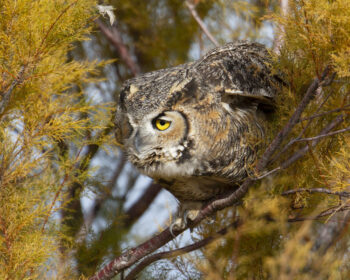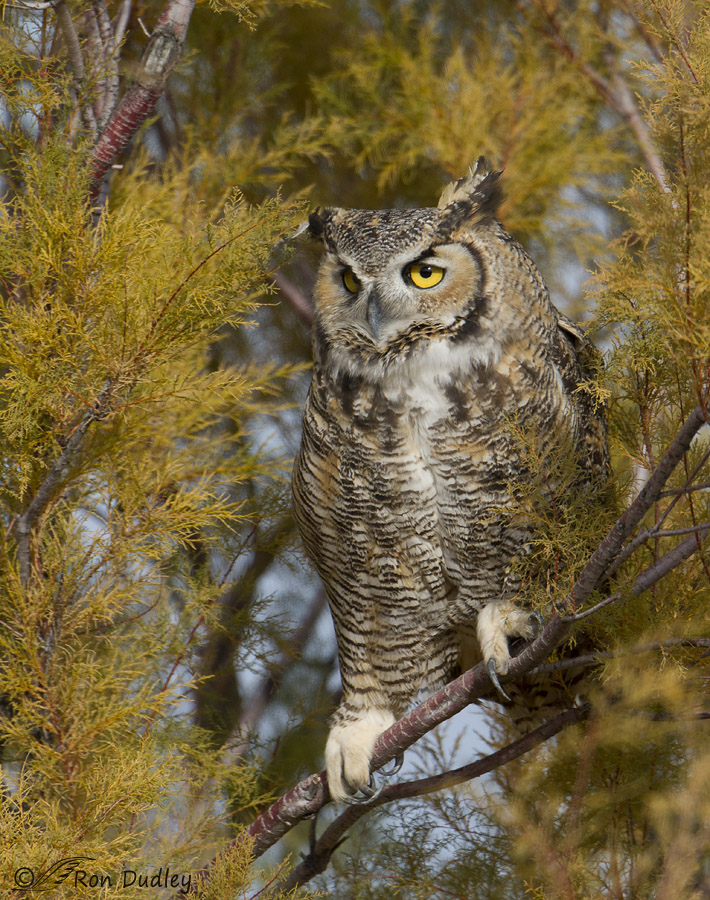Tag: tamarisk
Great Horned Owls In Tamarisk
Great Horned Owl Framed By Tamarisk
Typically when I find a Great Horned Owl in a natural setting it’s so deeply buried in the tree or foliage that it can barely be seen. This is a deliberate behavior, at least in part to avoid mobbing birds of many species. Crows, for example, will invariably mob an exposed GHO, pursuing it from tree to tree and calling out to other crows to recruit them to join in. 1/800, f/8, ISO 500, 500 f/4, 1.4 tc, natural light, not baited, set up or called in This owl, and one other, perched in the tamarisk for about a week but on most days they were virtually impossible to see unless you knew where to look. But on two cold, early mornings I found one of them in this spot where it was exposed to the warming rays of the sun. Its breast and belly feathers are wet, as are the drooping ear tufts. These birds sleep during much of the day but their slumber is light and alert as evidenced by their ear tuft (“horn”) movements in response to any slight sound, even with eyes closed – a behavior that’s interesting to observe if you’re lucky enough to be sufficiently close to a sleeping owl. Ron
Rough-legged Hawk on Tamarisk
I’ve said before that for me the Rough-legged Hawk is among the most handsome of North American raptors. 1/2500, f/6.3, ISO 500, 500 f/4, 1.4 tc I found this bird perched on some tamarisk just below an elevated road on Antelope Island and was able to get some shots I like as it lifted off. I’ve posted another image of the sequence here. In late April of this year state park personnel cut down the stand of tamarisk. I fully understand the need to get rid of them because tamarisk is an invasive plant that is widely believed to degrade native wildlife habitat and disrupt the structure and stability of North American native plant communities. That said I will miss them as there aren’t many elevated and attractive natural perches on the island. Ron
Just A Shot That I Like… #5 – Great Horned Owl In Tamarisk
We recently found a Great Horned Owl that likes to hang out in some tamarisk close to the Great Salt Lake. Usually the owl is deeply buried in the foliage and can’t even be seen unless you know where to look but of course getting clear shots of the bird is impossible in that situation. 1/2000, f/7.1, ISO 500, 500 f/4, 1.4 tc However on cold early mornings this bird likes to get a little warming sun and has found one spot where it’s open enough that it can soak in some rays and still feel safe and hidden by the enclosing tamarisk. By careful maneuvering I can get a relatively clear view of the owl from a close vantage point (without disturbing it). It’s a busy setting for the bird but I like that the spot it has chosen to warm up in is so dense with leaves that they almost seem to wrap protectively around the owl. We’ve had several opportunities with this bird in exactly the same spot over the last couple of weeks. At least we thought it was a single bird but then yesterday sharp-eyed Mia noticed (while editing and culling images) that the plumages don’t match from day-to-day. There are two owls that use this spot and we have photos of both of them. A pleasant surprise! Ron



